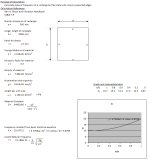Panel Vibration

Description
Calculate natural frequency of a rectangular flat plate with simply supported edges.
Calculation Reference
Harris' Shock and Vibration Handbook
Harris's book on shock and vibration is a well-known reference work in the field of mechanical engineering and structural dynamics, titled 'Harris' Shock and Vibration Handbook'. The book was first published in 1959 and has been updated through multiple editions. The latest edition, the sixth edition, is edited by Allan G. Piersol and Thomas L. Paez. This comprehensive handbook provides a wealth of information on shock and vibration theory, measurement, testing, and control.
The book covers a wide range of topics related to shock and vibration, including:
- Basic theory and concepts of shock and vibration
- Measurement and analysis techniques for shock and vibration data
- Vibration testing procedures and equipment
- Shock and vibration standards and criteria
- Design and analysis methods for shock and vibration isolation
- Vibration control and damping techniques
- Structural dynamics and response to shock and vibration
- Applications of shock and vibration analysis in various industries, such as aerospace, automotive, and electronics
Harris' Shock and Vibration Handbook is a valuable resource for engineers, researchers, and students working in the fields of mechanical engineering, structural dynamics, and applied mechanics, as well as professionals involved in the design, testing, and analysis of structures and components subjected to shock and vibration.
Calculation Preview
Full download access to any calculation is available to users with a paid or awarded subscription (XLC Pro).
Subscriptions are free to contributors to the site, alternatively they can be purchased.
Click here for information on subscriptions.


